Family : Macropodidae

Text © DrSc Giuliano Russini – Biologist Zoologist

English translation by Mario Beltramini
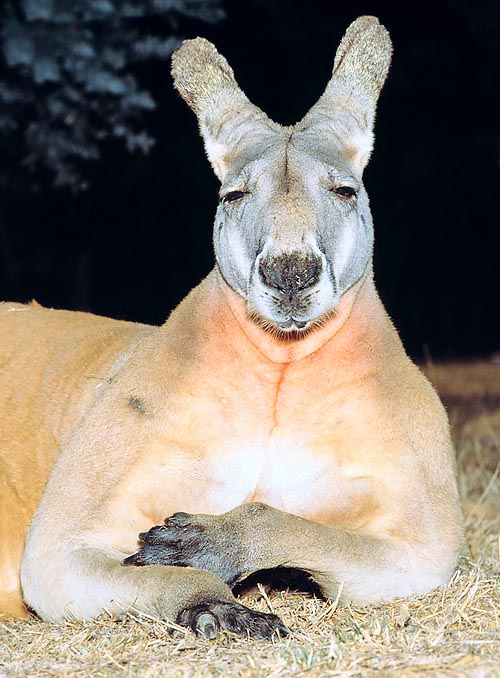
Red kangaroo (Macropus rufus) is the greatest extant marsupial © Giuseppe Mazza
The other great peculiarity characterizing all marsupials is the reproductive modality. The females of the species afferent to the various families of this order, have, in fact, equipped themselves, at a certain moment of their natural history, of an incubating pouch where (as we shall see later) great part of the embryo-foetal development takes place; pouch having the well known name of “marsupium”.
This anatomic oddity has rendered the females of this order totally, or almost, free by the need of having an annex or inner maternal-embryonic membrane, essential on the contrary in the eutherians, the “placenta”, which originates from the collaboration between the maternal uterine endometrium and the tropho-ectoderm of the implanted embryonic blasocyst.
In the modern mammals, rightly called eutherians, this last serves for the nutrition and the oxygenation of the foetus inside the uterine gestational chamber, where the development continues till the birth; whilst, in the rare cases of marsupials where there is rudimental placenta, this forms from the yolk sac, but the genus Perameles, where there is a simple “allantoplacenta”.
For such reason, the biologists define the Eutherians (Eutheria) placental or placentate viviparous mammals, whilst they call, on the contrary, the Marsupials (Marsupialia) aplacental or aplacentate, viviparous mammals.
Obviously, the marsupials as well as the monotremes (see Monotremata ) are amniotic organisms, like all mammals, all birds, all reptilians, whilst amphibians and fishes, having no amniotic sac, are defined as anamniotic.
The order of the marsupial mammals (Marsupialia), subdivides into eight families, which biogeographically localize in Oceania, in the specific, in Australia, Tasmania, New Guinea and nearby islands, as well as in South America and, with one species only, in the southern USA.
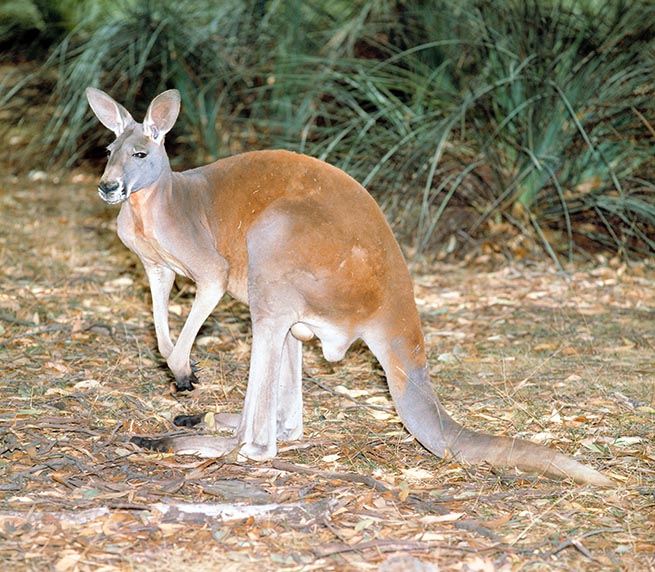
Endemic to Australia, from the western coast to inland © Giuseppe Mazza
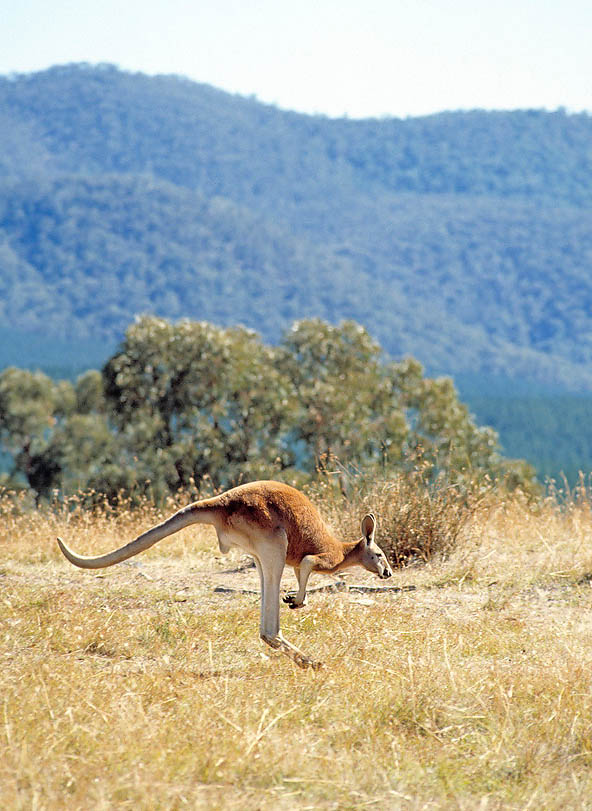
With 3-4 m leaps, it may reach the speed of 30-50 km/h © Giuseppe Mazza
Zoogeography
The Macropus rufus is endemic to Australia, from its western coast up to the inland.
Ecology-Habitat
These splendid jumpers have the tendency to prefer the arid zones (where occur rainfalls of less than 500 mm of atmospheric rain per year), the bush and the shrubby thicket, the vast prairies, the zones with Mediterranean thicket and with savannah, which allow it, rightly, to move by jumping (gait common to all kangaroos species, with which they may attain the 3 m of height and the 4 m of length), preferring therefore to avoid entering into the pluvial forest, as well as the eucalyptus forests.
They tendentially nourish of various species of graminaceous plants, but, in conditions of extreme drought, they may nourish of plants which are normally ignored by most of the herbivores.
This capacity of alimentary adaptation, to which adds a poor demand of water, because they drink very little, avoiding the dehydration thanks to a very concentrated urine, allows them to live well also in this rather extreme areas. The IUCN declares a status of “locally common” for this species.
Morpho-physiology
There are three species of big kangaroos, afferent to the genus Macropus, which means with large feet, but the high number of subspecies has originated a great confusion both in the scientific nomenclature, as the International Code for Zoological Nomenclature (ICZN) pinpoints, and in the popular one. As briefly told before, the red kangaroo is by far, the biggest species of marsupials in our planet.
It is as tall as a man, maybe even little more; it stays in an erect position on the two robust and strong hind limbs, with which it effects its powerful leaps (for staying in such position it takes advantage also of the robust tail, which acts also as a rudder during the jumps), with which it may reach the speed of 30-50 km/h; when seated, it uses the tail like a chair, resting.
The upper limbs are small and are utilized in the fights between males, or, by the females, for defence.
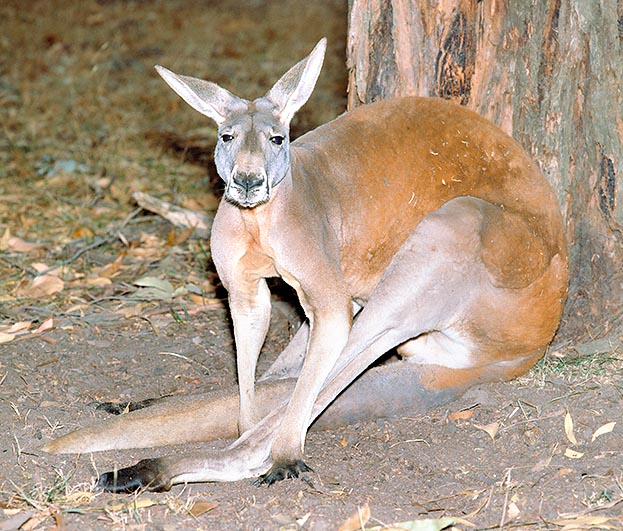
The tail acts as balance, good for sitting and kicking, in fight, from this position © Giuseppe Mazza
These are characters of sexual somatic dimorphism, which are evident also in the dimensions in favour of the male who may reach the 100 kg of weight, per 1,40-1,70 m of lengths, to which are to be added 1,20-1,20 metres of tail, whilst the female has a length of 0,85-1,00 m, with a 70-90 cm tail, per a weight of 60-70 kg.
The confusion in recognizing the species increases furthermore, just because the female of the red kangaroo has grey hair, whilst many wallaroos, common name under which are identified species of kangaroos with intermediate dimensions between those of the wallabies and those of the great kangaroos; an example is the Common wallaroo, or north-western Australia wallaroo (Macropus robustus) which has a red mantle.
The three species: Common wallaroo (Macropus robustus), Great grey kangaroo (Macropus giganteus) and Red kangaroo (Macropus rufus), may be distinguished more easily considering the snout: glabrous in Macropus robustus, hairy in Macropus giganteus, and with a limited hairless are in the Macropus rufus.
The female of the red kangaroo stops its growth by the fourth year of age, once the sexual maturity has come, whilst the male keeps growing till the tenth year. In the wild, the longevity reaches the 23 years; in captivity, they may reach even the 30. The morphological lines common to such order tell us that the pelves support the epipubic bones, like those of the monotremes and of many reptilians; once, the zoological biologists called these bones “marsupial”, a name which, in reality, causes confusion as they do not support the marsupium at all, and are present in both sexes.
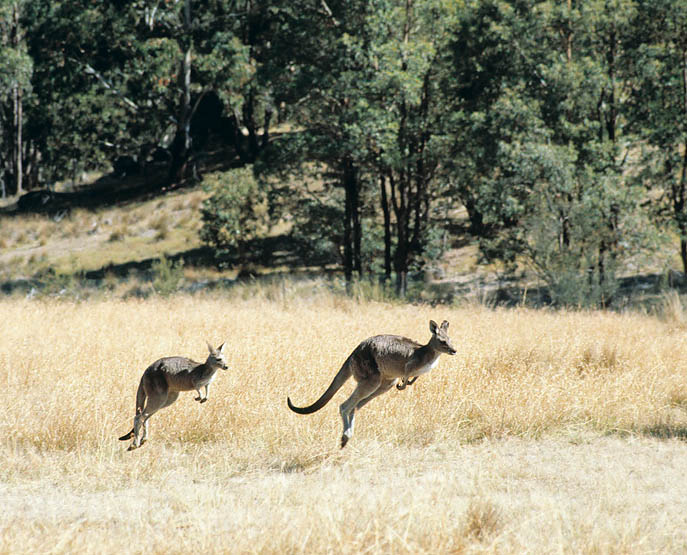
It prefers open spaces to forest; females are greyish-blue © Giuseppe Mazza
The encephalon is fairly small, if compared to the size of the animal and, like for the monotremes, lacks of the corpus callosum.
A common character to all the species afferent to the eight families of marsupials, is that the hind extremity gradually tapes in the tail; a way which recalls that of the lizards and which contrasts with the base of the tail of the eutherian mammals.
Also in the red kangaroos, mike in the other species of kangaroos, there is a sternal gland, gland which, in the arboricolous marsupials, serves, through the secretion it emits, to mark the territory, whilst in the kangaroos is still of unknown signification.
The red kangaroo, like all marsupials, is voiceless (unlike the eutherians), it emits only some whistles or grumbles when alarmed; only the flying phalangerid marsupials, in reality, emit, while flying, cries which may be heard also from far away.
Even if they are endothermal-stenothermal animals and can regulate the body temperature better than the monotremes, they go numb, however, during the cold season.
Like the other species, the red kangaroos live usually in small mobs of a ten of individuals, which may increase in the catering areas, while they are busy eating.
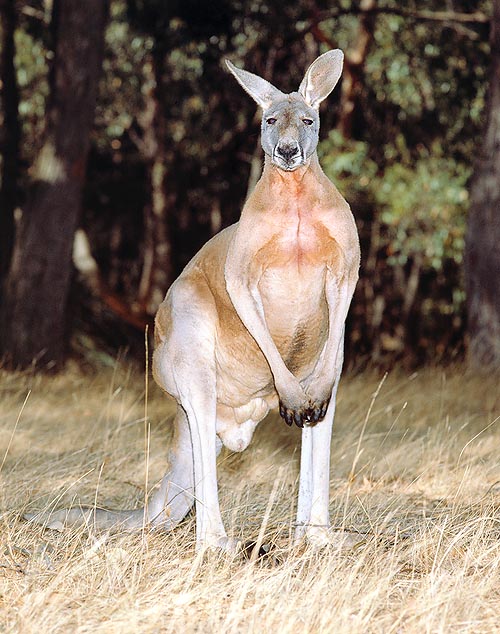
Taller than a man, when standing up, they can run away or attack © Giuseppe Mazza
The fourth toe of the hind legs is very long, the second and the third ones are syndactylous, that is, merged together; the first toe is absent; the short fore legs have five toes and the tail is much robust.
For long, it has been thought that the kangaroos, included therefore the red one, were capable to spread apart the lower, protruding forward, incisors and so, to utilize them as scissors for cutting the grass.
More specific studies carried on in the seventies of the last century, have shown that this hypothesis is wrong: the two halves of the mandible are not united and consequently the teeth may spread, but not for being used as scissors.
When the animal grazes and seizes the grass with the mouth, the lower incisors spread in way to get closer to the upper ones for catching the food, which then is pulled up like is there was a pair of pliers and not cut.
Once the food is in the mouth, the lower incisors approach in way that the molars may chew it, with a rotary motion of the jaws, without any clash of the lower incisors against the upper ones.
A good part of the food is then regurgitated to be chewed again thanks to a sort of spiral groove present in the stomach. In some parts of Australia, the red kangaroos, as well as the other bigger species, are still now considered as pests by the owners of flocks of sheep. During the fifties and sixties of the XX century, these animals were hunted for selling their skins and the meat: in 1966, one unique farm of Queensland was able to treat even 2.000 carcasses per week!
The hunting to these animals was initially stimulated by a legend after which these herbivores eat as much as eight sheep; in reality, if compared to their dimensions, they eat as much as a sheep.
They are however in competition with these ovines for some of the most nutrient grasses, even if, normally, they do not graze the shoots of the plants which are palatable to the ovines.
During the eighties of the last century, the Australian government has declared illegal the hunting to the kangaroos, limiting their negative effect, on the pastures for the sheep, with a special enclosure, long a 5.000 km, which cuts most of Australia, isolating them in vast areas dedicated to them.
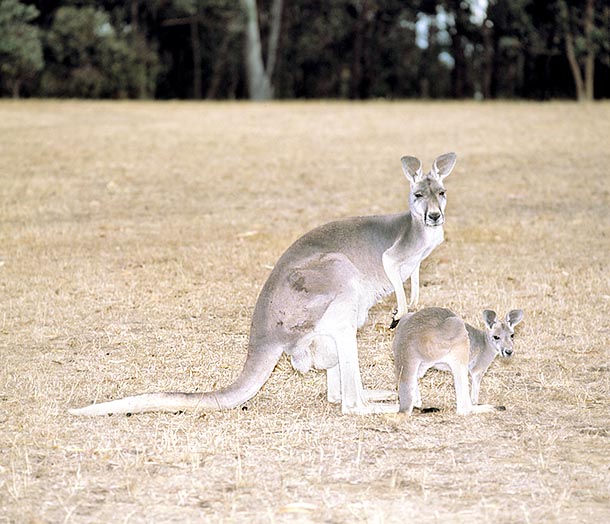
In or out from marsupium, fertile females have always a young to care © Giuseppe Mazza
Ethology-Reproductive Biology
The uterus and the vagina of the marsupials are twofold and end in a cloaca; from this situation comes the name of a family, the Didelphids (Didelphidae), that is with double uterus, not to be mistaken with the bicornuate or biparted uterus of the mare.
In the male, the penis is forked at the tip and is placed behind the scrotum.
In the marsupials, and therefore also in the red kangaroo, the offspring comes to light in a very early stage of development and remains attached to the nipples of the mother (four in the kangaroos), usually, but not always, in an abdominal pouch; in any case, in the kanga- roos, the marsupium is always abdominal.
Red kangaroo, as well as the other species of Macropodidae, gives birth to one young at the time.
In these mammals there is the phenomenon of the “diapause”, quite common in the insects like the Coleoptera and the Lepidoptera, etc., in the reptilians, present in various species of birds, whilst in the mammals it is found in the marsupials, the pinnipeds, the cervids, the lagomorphs, in the Brown bear (Ursus arctos), as well as in the Polar one (Ursus maritmus) and in some species of mustelids.
In all these animals, the slowdown of the biological processes is an eco-physiological strategy for the survival of the unborn kangaroos.
In the various species of kangaroo, the diapause in the foetal development is connected with the lactation, the corpus luteum, with the presence of a “joey” (an immature kangaroo not yet weaned) and with the ambient conditions, for instance, the drought. Before entering the complex reproductive mechanisms, we have to examine closely the ethology of this animal.
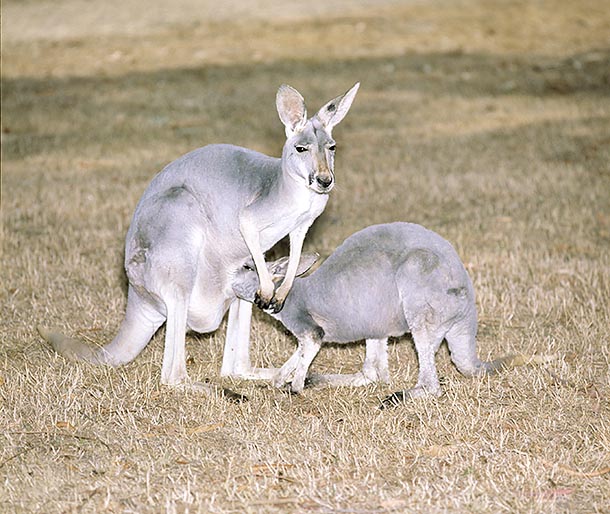
A now grown joey still looks for milk in the pouch. Independence comes when 3-4 © Giuseppe Mazza
Even if the greatest macropodids move in mob, they show little of that social behaviour which can be observed in the gregarious eutherian mammals; the animals of a group exchange continuously with those of others and do not show any sign of permanent “group links”.
When the climatic conditions are good, the kangaroos occupy a restricted space and it does not seem that they defend a territory, but when the weather is unfavourable, like in the drought periods, they migrate for long distances.
The of the kangaroos drinking at the borders of a pond, is rightly showing how each individual keeps a certain distance from its neighbours, about 60 cm in this instance, in contrast to the side by side typical of many African herbivores.
The great Swiss biologist, H. Hediger, father of the zoo-biology, has pinpointed thanks to his studies done during the fifties of the last century how, in the wild as well as in captivity, an alarmed kangaroo assumes an erect position in order to get a good vision of the surroundings and to discover if there is the menace of some danger: the erect position is therefore the characteristic of the defence, and of the aggression too.
If in a zoological garden a man walks inside a fence where red kangaroos are confined, these ones perceive the erect position of the person as an expression of aggressiveness, and will react consequently.
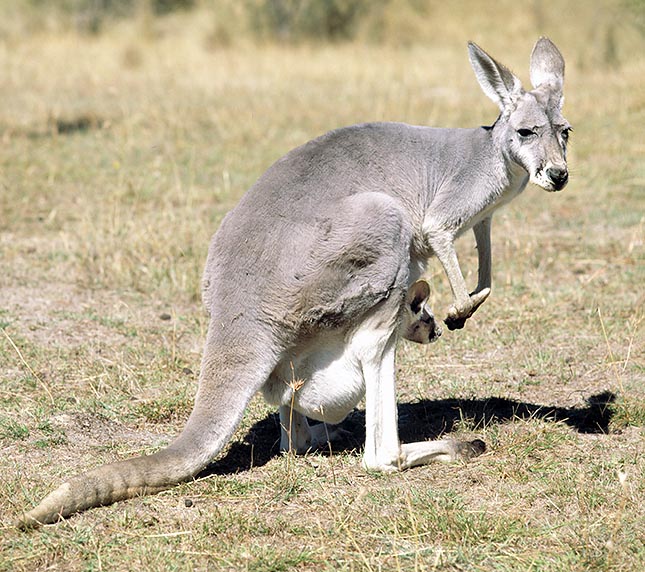
If vegetation is poor or the pouch is taken, the embryo stops growing and starts diapausa © Giuseppe Mazza
If the man inside the fence cowers in an attitude which recalls that of a calm kangaroo, the animals, in nine cases out of ten, do relax, their aggressiveness disappears and ignore the intruder.
Let’s talk now about the reproductive cycle of the red kangaroo, equivalent to that of the other macropodids. The Red kangaroo (Macropus rufus), like the Common, or north-western Australia, wallaroo (Macropus robustus), does not have a regular reproductive season; in any moment, some females may be pregnant, others in oestrum and others more, carry the small joeys in the marsupium.
Once the female, in a squatting position, has delivered a young and this is in an extremely precocious stage of develop- ment, there is always another post-partum oestrum; the new fecundated egg, however, does not go beyond the stage of blasocyst and remains, quiescent, in the uterus. Rigorously talking, it is not matter, however, of a delayed implantation, as in the metatherians a true and proper implantation, like the eutherians, does not take place.
When the vegetation grows up again, luxuriantly, the blastocysts present in the diapausa of the females with almost mature joeys in their marsupia, begin to develop. The oldest joeys will abandon then the marsupium to cease the place to their successors, whilst those not so much advanced in the development, will quickly complete the growth in order to leave it them too, when the new guests will have finalized the short uterine gestaton.
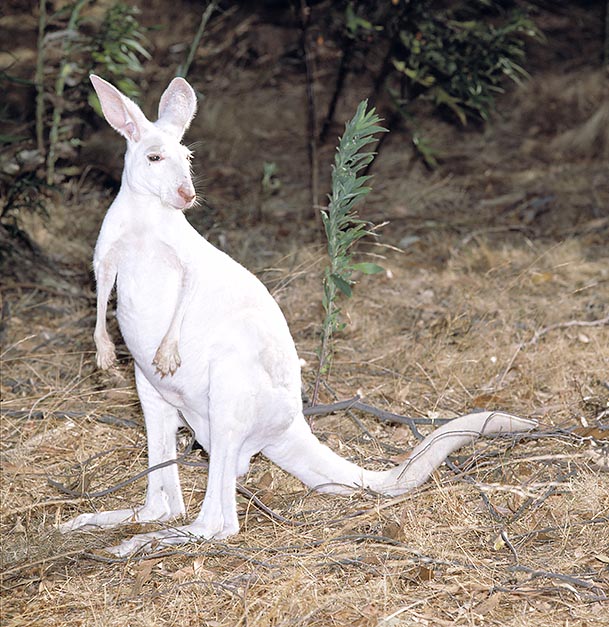
Rare specimen of albino Macropus rufus © Giuseppe Mazza
The kangaroos are consequently able to reproduce in climatic conditions where eutherians of analogous dimensions and alimentary diets would be unable to do so. Such a type of retarded development, as we said, is known under the term of “embryonic diapausa”.
The diapausa is controlled by the lactation or by the nursing, so that, as soon as a joey is weaned or incidentally passes away, it stops and the blastocyst resumes its activity, getting out from the suspended animation in which was staying. The embryo of a joey, during the delivery, gets out from the vagina with the head first, wrapped by the amnion which will break, contrary to the bovines and the eutherian equines, where the newborn get out with the legs first.
It looks immediately for the marsupium, crawling on the belly, and attaches to the nipple. This distance corresponds to about 13-16 cm. The just born joey is a few millimetres long and weighs about 2 g. The intrauterine gestation lasts only 30-34 days, whilst, in the marsupium, it is of 7-8 months. The independence from the mother, for both sexes, occurs by around the third-fourth year of life.
